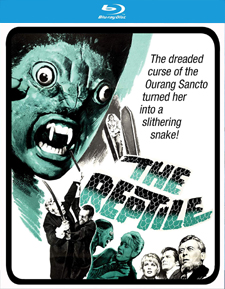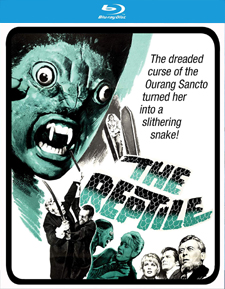Reptile, The (Blu-ray Review)

Director
John GillingRelease Date(s)
1966 (July 30, 2019)Studio(s)
Hammer Films/Seven Arts Productions/20th Century Fox (Shout!/Scream Factory)- Film/Program Grade: B-
- Video Grade: B
- Audio Grade: B-
- Extras Grade: B
Review
Shot back-to-back with The Plague of the Zombies as a cost-cutting measure (which ultimately didn’t work out), The Reptile used many of the same sets and even some of the same cast members to realize its tale of a vicious snake woman plaguing the English countryside. Both films were released in 1966, but on separate bills to avoid direct comparisons. The Plague of the Zombies went out to theaters paired with Dracula: Prince of Darkness and The Reptile shared its marquee with Rasputin the Mad Monk.
In a small Cornish village, a rash of unusual and unexplained deaths are occurring. One of the victims is the brother of Harry Spaulding (Ray Barrett), who arrives in the village with his newly-wedded wife Valerie (Jennifer Daniel) to inherit his brother’s cottage and make a home there. A local bartender named Tom (Michael Ripper) informs them of what the locals are calling the “Black Death,” and to be wary of the reclusive Doctor Franklin (Noel Willman). Upon meeting the doctor, his beautiful but troubled daughter Anna (Jacqueline Pearce), and their Malayan servant (Marne Maitland), Harry and Valerie come dangerously close to finding themselves face-to-face with a hideous and deadly snake woman, whom Franklin is attempting to keep hidden away.
The Reptile can be seen as a reinterpretation of the werewolf legend, but it also contains a perceived (and certainly unintentional) homoerotic subtext between the characters of Harry and Tom. Despite these curious aspects, the overall film is a mildly run-of-the-mill horror exercise. The makeup of the snake creature, for instance, is both effective and ineffective, meaning that parts of it work quite well, including the fangs and the eyes, but the snake skin, which is nothing more than a body suit of sorts, keeps one well aware of the fact that this is indeed a person in a costume (of which a claustrophobic Jacqueline Pearce was not too happy with).
On the other hand, the way that each of the victims die is quite horrible. In the Dracula films, they are mostly bitten on the neck and the bloody fang marks are discovered after their death, but in The Reptile, they foam at the mouth and turn shades of green and black while dying, which is relatively disturbing and brutal to say the least. At the same time, this snake venom seems to only be effective when the script needs it to be. It acts rather quickly on certain characters, killing them off in seconds, while for others, it can be bled out much like a normal snake bite, even after having been infected with it for several minutes.
The performances are mostly good, including those from Michael Ripper and Noel Willman, the latter of whom takes the material very seriously, giving a strong speech at the end which is a long, drawn-out bout of expository dialogue (while a fire rages out of control below him in his own house, but nevermind). There’s also a component of out-of-the-box thinking at play with the film’s inclusion of a sitar music performance, which many audiences hadn’t seen at that time, as well as the exploration of the mysticism of snakes and how they’re potentially exploited by other cultures, making the story a bit more extraordinary than a traditional gothic horror tale. The basic horror trappings hung upon it make for an easily repeatable watch, but the various elements make for a simultaneously unorthodox yet simple narrative, particularly for a Hammer film.
Scream Factory debuts The Reptile on Blu-ray in the US for the first time with an older HD transfer used for the film’s UK Blu-ray release, and is presented in two different aspect ratios: 1.66:1 and 1.85:1. While a fresher scan would certainly have given the film more bite (no pun intended), the presentation provided here is a mostly ideal one. Grain is uneven, mostly during the opening and closing credits, as well as transitions, but detail is strong nonetheless. The color palette is slightly uneven in spots, with a couple of shots appearing a bit washed out; but for the most part, the use of lighting gels, as well as the countryside foliage, appears lush. Black levels are also uneven, sometimes appearing a darkly grayish blue, and shadow detail often suffers in low light shots (with the caveat that some of it might be baked into the original film materials). Contrast and brightness levels are spot on during indoor scenes, but moments during the day-for-night shots are problematical. Everything appears stable and clean with only minor speckling and an occasional scratch or two here and there leftover.
The audio is presented in English 2.0 mono DTS-HD with optional subtitles English SDH. It’s quite a narrow presentation that sounds just a bit too clean, particularly during quieter moments or low levels of dialogue. Everything is clear and discernable, including the film’s score, but sound effects aren’t all that impactful. Sync issues never arise and the track as a whole is free of hiss, crackle, dropouts, and distortion.
Bonus materials include a new audio commentary with film historians Steve Haberman, Ted Newsom, and Constantine Nasr, all of whom are always worth listening to as they provide plenty of interesting information about the film, its production, and its cast and crew; a new 22-minute interview with assistant director William P. Cartlidge; The Serpent’s Tale: The Making of The Reptile, a 23-minute documentary featuring Hammer Films historian and author Marcus Hearn, actor and writer Mark Gatiss, author Jonathan Rigby, musician and author David Huckvale, author Wayne Kinsey, art director Don Mingave, and technical restoration manager for Pinewood Studios Jon Mann; the 25-minute Wicked Women episode of The World of Hammer, narrated by Oliver Reed; 2 UK trailers, one double featured with Rasputin the Mad Monk; the US trailer, also double featured with Rasputin the Mad Monk; 2 TV spots, also double featured with Rasputin the Mad Monk; an animated still gallery containing 49 promotional and behind-the-scenes photos; and an animated poster and lobby card gallery containing 63 images, including magazine covers and press materials. It’s worth nothing that a few extra bits of bonus material were not carried over from previous releases. Not included from the Anchor Bay DVD is The World of Hammer episode Vamp; not included from the Green Cow Region 2 DVD are 2 episodes of The World of Hammer: Thriller and Costumers; and not included from the StudioCanal Region 2 Blu-ray is a 3-minute Restoration Comparison featurette.
Many consider The Reptile to be one of Hammer’s more effective chillers. It’s mid-level Hammer, which doesn’t live up to the strengths of Horror of Dracula and The Curse of Frankenstein, but it’s an enjoyable if imperfect genre entry, one that Scream Factory has given plenty of TLC.
– Tim Salmons

